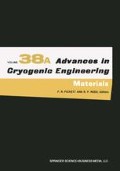Abstract
The interlaminar shear strength of glass-film-glass organic composites has been tested to check the integrity of the insulating materials used in forced-flow superconducting magnets.
The glass-film-glass (GFG) composites are used as the adhesive insulating material in forced-flow superconducting magnets. The interlaminar shear strength (ILSS) is an important characteristic in maintaining a highly rigid magnet.
Compressive shear tests were performed on GFG materials with different process conditions. The ILSS values of GFG material were found to be low compared to those of conventional composites. The radiation damage of ILSS in GFG material was also examined. It was found that a change of failure mode was brought about by reactor irradiation.
Access this chapter
Tax calculation will be finalised at checkout
Purchases are for personal use only
Preview
Unable to display preview. Download preview PDF.
References
H. Nakajima, K. Okuno, H. Tsuji, K. Yoshida, K. Koizumi, T. Isono, E. Yaguchi, H. Shimane, and S. Shimamoto, Mechanical characteristics in the experiment of the Nb-Ti demo poloidal coils, Proc. MT-11, 824 (1989)
K. Okuno, H. Tsuji, Y. Takahashi, H. Nakajima, K. Kawano, T. Ando, T. Hiyama, M. Nishi, E. Tada, K. Yoshida, K. Koizumi, T. Kato, T. Isono, H. Yamamura, M. Satoh, J. Yoshida, N. Itoh, M. Oshikiri, H. Nisugi, M. Konno, E. Kawagoe, Y. Kamiyauchi, M. Hasegawa, Y. Matsuzaki, and S. Shimamoto, The first experiment of the 30-kA Nb-Ti demo poloidal coils, Proc. MT-11, 812 (1989)
T. Hirotsu and S. Ohnishi, Surface modification of some fluorine polymer films by glow discharges, J. Adhesion 11: 60 (1980)
T. Kasemura, S. Ozawa, and K. Hattori, Surface modification of flourinated polymers by microwave plasmas, J. Adhesion (in Japanese) 25: 222 (1989)
J. R. Dann, Forces involved in the adhesive process, J. Colloid and Interface Sci. 32: 2–302 (1969)
Author information
Authors and Affiliations
Editor information
Editors and Affiliations
Rights and permissions
Copyright information
© 1992 Springer Science+Business Media New York
About this chapter
Cite this chapter
Ueno, S., Nishijima, S., Okada, T., Maruyama, M. (1992). Glass-Film-Glass Hybrid Organic Composites for Forced-Flow Fusion Magnets. In: Fickett, F.R., Reed, R.P. (eds) Materials. Advances in Cryogenic Engineering, vol 38. Springer, Boston, MA. https://doi.org/10.1007/978-1-4757-9050-4_48
Download citation
DOI: https://doi.org/10.1007/978-1-4757-9050-4_48
Publisher Name: Springer, Boston, MA
Print ISBN: 978-1-4757-9052-8
Online ISBN: 978-1-4757-9050-4
eBook Packages: Springer Book Archive

